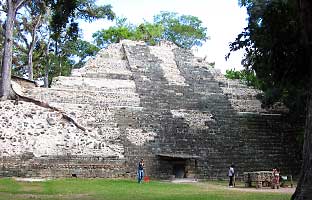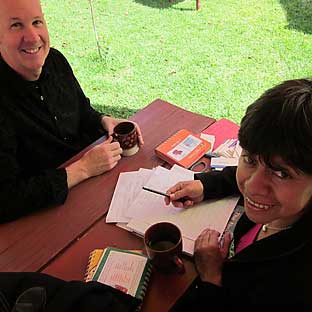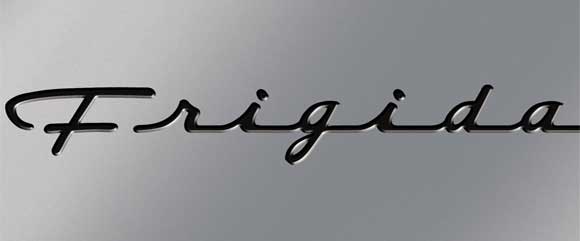Copan Ruins in Honduras
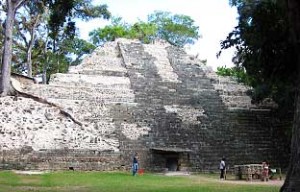 Traveling in Central America is a lot like traveling state to state in the USA, but with a much bigger difference in dialect and traditions. Guatemala boasts one of the best Mayan archeological sites with Tekal, whereas Honduras has the ruins of Copan. Copan is known for having more intact Mayan hieroglyphic stone writings.
Traveling in Central America is a lot like traveling state to state in the USA, but with a much bigger difference in dialect and traditions. Guatemala boasts one of the best Mayan archeological sites with Tekal, whereas Honduras has the ruins of Copan. Copan is known for having more intact Mayan hieroglyphic stone writings.
Getting to Copan
I’m not sure how she she did it, but the dazzling smile of my Israeli friend Hagar convinced me to the insane act of getting up at 3:30 am on a Saturday morning to be reading for a micro-bus shuttle pickup in Antigua, Guatemala. The shuttle arrived around 4:20 am and the whole time I kept thinking, “I could have had another half hour of sleep!” The ride itself was just more Guatemalan roads filled with speed bumps, potholes and winding turns, enough to make anyone motion sick. At around 10:30 we arrived at the Honduras border where we paid a small fee to exist Guatemala and another to enter Honduras and adding two more stamps to my Passport. We all loaded back up in the shuttle and continued about another 45 minutes to the small colonial town of Copan.
Copan Ruins
After a brief lunch a group of six of us from our shuttle decided to see the ruins together. Entrance cost us about $15 and we all contributed toward the $25 fee for a guide. Our guide boasted constantly about how much he knew about the ruins, about how he personally discovered bones of ancient Mayan kings at the ruins, how his father taught him how to truly read the Mayan hieroglyphs, etc etc. His english was extremely difficult to understand and because english was a second language for everyone in our group except for me, everyone else gave up after a short time on trying to listen to him and kept wandering away. Our guide felt like a sheep herder trying to round everyone up to follow him to the next display. Personally I thought the $25 was completely waisted on him because not much of what he said was understood and what I did understand was so full of bragging and boasting it was hard to listen to. However, taken in stride, it was very entertaining even if it wasn’t very informative.
Ball Court
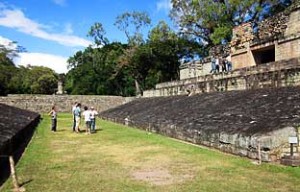 I liked the ball court which is the second largest central america. It is a variation on the game that I’ve seen at other Mayan ruins. Instead of getting a rubber ball through a small hole, you just had to hit one of several stone heads along the slopping walled area. I don’t think I would want to be the captain of the winning team because after the game, the captain would be sacrificed to the gods. No thanks!
I liked the ball court which is the second largest central america. It is a variation on the game that I’ve seen at other Mayan ruins. Instead of getting a rubber ball through a small hole, you just had to hit one of several stone heads along the slopping walled area. I don’t think I would want to be the captain of the winning team because after the game, the captain would be sacrificed to the gods. No thanks!
Great Plaza with 7 Kings
The plaza area is famous for its various stelae and alters. Our guide told us that several of the stelae were replicas and originals in various museums. He insisted he would show us only the real stelae and avoided almost all those on display making us wonder if he was just trying to shorten the tour. I did like that there were seven stelae in one area, one devoted to each of the kings that ruled during that time.
Hieroglyphic Stairs
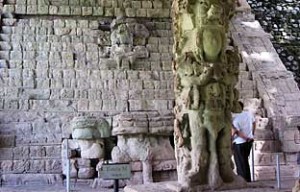 The most famous of Copan’s monuments, 63 steps and several thousand glyphs tell the history of the royal house of Copan and is the longest known text of ancient mayan civilization. Unfortunately, the steps have fallen out of place leaving the exact meaning indecipherable. But our guide indicated he knew the meaning of each as he drew figured in the dirt where we sat and explained how to read and pronounce Mayan. I love languages, so I did find that part interesting!
The most famous of Copan’s monuments, 63 steps and several thousand glyphs tell the history of the royal house of Copan and is the longest known text of ancient mayan civilization. Unfortunately, the steps have fallen out of place leaving the exact meaning indecipherable. But our guide indicated he knew the meaning of each as he drew figured in the dirt where we sat and explained how to read and pronounce Mayan. I love languages, so I did find that part interesting!
Tunnels and Museum
We didn’t pay the extra $20 to go into the tunnels. But our guide continually urged us to go there. There are two tunnels that allow you to see what is under the acropolis. We didn’t pay to get into the museum either. I don’t think we missed much at either location.
The City of Copan
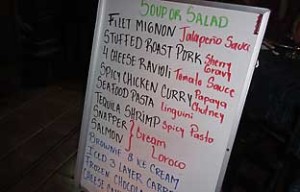 It is small, more of a town that a city which could be easily walked. I’d guess it was 10 blocks one way by 12 blocks the other way. We ate at a nice restaurant one night which had no printed menu. Instead, they had a marker board with the evenings choices on it. After you were seated the waitress would setup the marker board on a nearby chair so you could choose among two or three choices. Every night had a random new menu making it a surprise to see what you would get. It was a wonderful, yet wacky, way to run a restaurant!
It is small, more of a town that a city which could be easily walked. I’d guess it was 10 blocks one way by 12 blocks the other way. We ate at a nice restaurant one night which had no printed menu. Instead, they had a marker board with the evenings choices on it. After you were seated the waitress would setup the marker board on a nearby chair so you could choose among two or three choices. Every night had a random new menu making it a surprise to see what you would get. It was a wonderful, yet wacky, way to run a restaurant!

